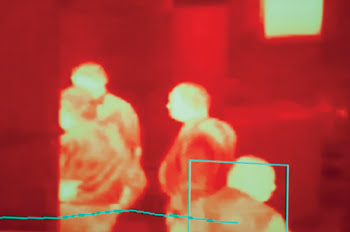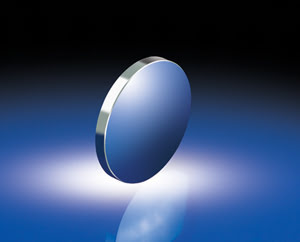The landscape of the infrared market has changed tremendously over the past 20 years, expanding in terms of commercial applicability, number of available components, widespread adoption and extreme growth in overall market value.
The IR market was once entirely categorized and dominated by military applications and government funding, but with the recent and drastic decline in the cost of IR detectors and a myriad of other factors, the paradigm is shifting and more IR applications are becoming available in commercial markets.

Law enforcement can step up surveillance efforts with IR imaging.
In 2008, a Maxtech International Inc. and Flir Systems Inc. report estimated that the worldwide IR market totaled $6.6 billion with approximately $2.4 billion tied specifically to IR imaging systems. Conservative estimates have these markets continuing to grow at a compound annual growth rate north of 15 percent through 2012, whereas more aggressive estimates predict growth of greater than 25 percent well into 2015. Completely determining the value and growth estimates of the IR market continues to be difficult because the vast majority of the value, approximately 80 percent, comes from military applications, according to Maxtech International.
In the mid-1990s, the military IR market began to reach a point of technological stagnation and saturation because of the long development cycle of second-generation focal plane arrays. Since the release of those arrays, the military market has seen tremendous growth, skyrocketing to its present value. As growth in the military sector once again begins to slow, the commercial sector is poised to grow much more rapidly, taking a more prominent share of the worldwide IR market.
As with the growth in the military IR market in the late 1990s, growth in the commercial IR market today is once again driven by advancements in sensor technology. As IR sensor manufacturers have begun to integrate microelectromechanical systems into the sensors and the production process, costs have decreased significantly, allowing for the commoditization of IR sensors. The Test, Measurement and Sensors Group of McGladrey Capital Markets LLC estimates that prices of IR sensors will continue to drop as much as 60 percent over the next four years, creating a large demand for commercially available IR sensors.
Besides these production processes and technological advancements, there are additional outside factors affecting the growth of the commercial IR market. In 2003, the European Commission released a multiphase draft law requiring vehicle manufacturers to increase pedestrian safety while promoting the use of modern technology to improve overall driver safety. The passage of this legislation requires all mid- and high-end cars in Europe to be equipped with pedestrian-recognition systems by 2015. These night-vision/object-recognition hybrid systems are driving the further commoditization and cost improvement of complete IR imaging systems.

Edmund Optics is continually developing products in the IR to take advantage of the expanding market. Courtesy of Edmund Optics.
With added demand and faster adoption cycles of IR technology, the business climate has been primed for increased investments in research and development, design and manufacturing of commercially available IR components. In 2008, Schott announced the expansion of its advanced optics line to include IR materials, signaling the increased availability of such specialty glasses for mass production. Its new line of IR glasses included the release of forward looking infrared-grade zinc sulfide, clear-grade zinc sulfide and five chalcogenide glass variations.
Vision enhancement systems, such as those required by the European Commission legislation, are composed of two major cost drivers: the bolometer sensor array and the IR lens assembly. With the commoditization of IR sensors driving prices to record lows, it seems that the factor most preventing widespread adoption of such vision enhancement systems has been the availability of IR lens assemblies. However, the primed business climate and increased availability of materials with improved transmission in the IR – such as germanium, zinc sulfide, zinc selenide, silicon, calcium fluoride, amorphous material transmitting IR and chalcogenide glasses – has led to an astounding increase in the availability of commercial off-the-shelf (COTS) components designed specifically for use in the IR.
This phenomenon is easy to see by simply surveying the number of COTS components available from optic component suppliers. For example, in the 2006 Edmund Optics’ Master Source Book, fewer than 100 different COTS items designed specifically for use in the IR were listed. In 2009, that number reached nearly 300 and has since grown to more than 525 items in the 2011 Master Source Book. Edmund Optics is not alone in its continued product development in the infrared, as numerous component suppliers also have increased their infrared component offerings. The dedication of component suppliers to this growing industry only stands to aid in the continued growth of this market and future advancements in commercially available IR systems.

The dedication of component suppliers to this growing industry will help ensure continuing market growth and the future availability of commercial IR systems. Courtesy of Edmund Optics.
The blending of these market influences has caused a directional shift in the wide-reaching business strategies for IR systems manufacturers and integrators. Companies whose business models have historically been driven by military contracts are now readying themselves for increased participation in the commercial market. In May 2010, Flir Systems acquired Raymarine, the British manufacturer of marine global positioning systems. The acquisition gave Flir Systems an instant increase in its commercial distribution network. At the time, Raymarine had approximately 1000 retail outlets and more than 400 OEMs of its marine global positioning systems.
Flir intends to integrate its commercial thermal imaging products into the Raymarine distribution network, greatly increasing the chances of widespread consumer adoption. Additionally, in June 2010, General Dynamics acquired Kylmar Ltd., the UK supplier of IR sensors and surveillance systems. The Kylmar acquisition illustrates General Dynamics’ strategic decision to vertically integrate and better position itself in the market of commercially available IR imaging systems.

Infrared imaging isn’t just for the military anymore. As the cost of IR imaging systems decreases, commercial applications are expanding. Even exterminators are starting to use thermal imaging instruments to seek out locations of rodent and termite infestations.
Even prior to the recent reduction in IR sensor costs and the widespread availability of IR components, the market had already begun to see increases in commercial uses of IR imaging systems. They were being used in applications ranging from industrial process control to predictive maintenance and from mammography to law enforcement surveillance. Heating and cooling companies across the US continue to adopt IR cameras to provide complete efficiency ratings. Exterminators are using thermal imaging to identify locations of rodent nests and termite infestations, thus reducing the amount of time spent surveying the property. This level of demand, despite the high cost of equipment procurement, has managed to sustain the commercial IR market until the commoditization of the necessary pieces occurs. That time is now.
With the widespread availability of COTS IR components continuing to rise, the cost barrier to commercial research and development is expected to be eliminated. This, coupled with the already drastic reduction in sensor costs, should spur further product adaptation from military uses to commercial uses, increasing the demand for commercial IR systems.

A European Commission draft law will require all mid- and high-end cars in Europe to be equipped with pedestrian-recognition systems by 2015.
The worldwide IR market is primed for significant growth over the next few years. Component suppliers, systems designers, integrators and systems manufactures are preparing for this technological boom. And consumers are waiting for the release of the next commercially available IR system – perhaps one that will change the way we see our lives.
Meet the author
David Henz is manager at Edmund Optics in Tucson, Ariz.; e-mail: [email protected].